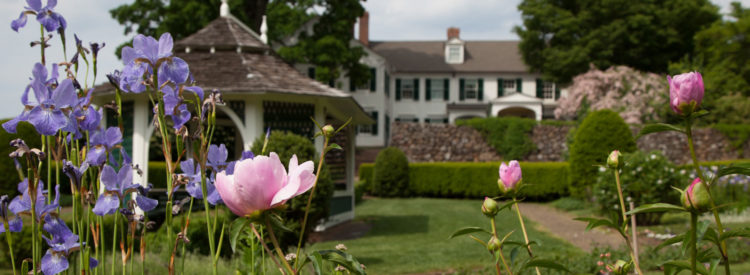By Dr. Anna Swinbourne
There is a spot in the drawing room, marked with an “X” in the nearby photograph, which is one of my favorites at Hill-Stead, if not the whole world. Standing on that spot, facing south to gaze at Monet’s haystacks in summertime, one can rotate clockwise to appreciate example after example of the magnificent paintings the Pope family acquired and installed in this room.
What is so very extraordinary about this particular arrangement is that within a single 360-degree rotation, the visitor can, through first-hand study of masterpieces, have a complete overview lesson in French Impressionism.
The introduction begins with the movement’s revered mentor, Edouard Manet, and his embrace of mid-19th century ideas about modernism – namely that to be modern one must attempt to place their finger on the pulse and particularities of the Now, and in so doing, an artist can assure their importance and appreciation by future generations.
This quest for modernity was sought by Degas, albeit through deceptively created scenes. Looking at Dancers in Pink, I feel as though I occupy the artist’s shoes, standing at an easel set up backstage and observing these performers as they wait in the wings, when in fact Degas could not have occupied this spot, as no man other than ballet professionals were then allowed in such places. The painting was actually carefully and imaginatively constructed in his own studio, fusing individual sketches of young dancers he had hired to serve as models there.
Degas’s traditional practice of creating the painting in his studio was anathema to his Impressionist contemporaries, who carried canvas, easel and materials out of doors to paint before the actual motifs that inspired them, which we see in full glory in the exceptional pair of haystacks, exquisitely positioned at 12 and 6 o’clock.
In fact, pausing my clock-hands-self at either hour and turning to the other, I can, with every bit of my being, understand an essential Impressionist aspiration: to revisit the same motif repeatedly and under different conditions – of day, season, weather – in order to capture a fleeting moment. The low, pale light of haystacks in a winter frost versus those set afire by midday summer sun. Perfect.
And pausing to savor that perfection, my eyes fall on Monet’s seascape of Antibes over the fireplace, an exquisite ending note. Through their dozen years of exhibiting together, from 1874-1886, the young rebellious Impressionists accomplished what they set out to – upend established norms about the type of subject that could be painted, the techniques used to do so, and the opportunities for their work to be appreciated by others – then they went their separate ways. Monet’s soon led him to the south of France, where he found favorite spots of his own, like this one on the Mediterranean.

